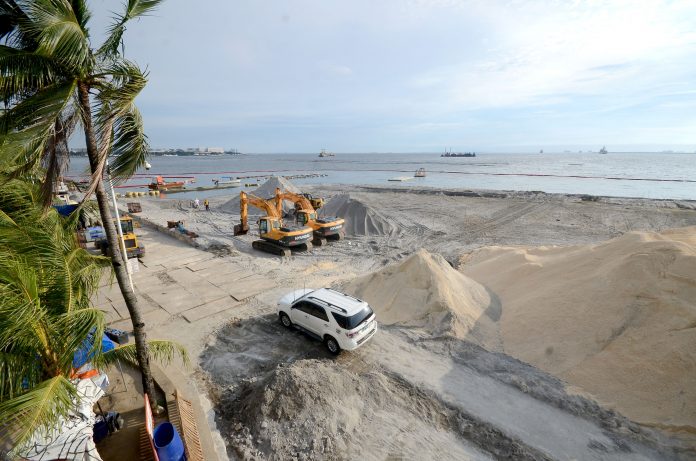Catholic Bishop Broderick Pabillo, Apostolic Administrator of the Archdiocese of Manila, said the controversial “beautification” of Manila Bay is “ill-timed” in the midst of the coronavirus pandemic.
“During these times, wherein many are without jobs and have no food to eat, this project amounting to over 300 million pesos just for the ‘white sand’ appears to be ill-timed,” he said in a radio interview.
“There are many incorrect things with this project, foremost is that it is not attuned with the current predicament of our nation,” said the prelate on Monday, September 7.
He said the money allotted for the project could have been allocated to help those in need, especially to provide jobs and give food to poor communities.
“We are not even certain if this ‘white sand’ will be able to stay there because tons of trash fill up Manila Bay whenever there are typhoons,” said the bishop.
Last week, the Department of Environment and Natural Resources has hauled about 3,500 metric tons of processed dolomite limestone to transform portions of Manila Bay into a white-sand beach.
Bishop Jose Colin Bagaforo of Kidapawan, head of Caritas Philippines, said the department seemed to be “confused” between saving and killing Manila Bay.
“The Environment department should correct this another major blunder in their so-called move to improve the situation in Manila Bay,” said the prelate.
He described the move as a “band-aid solution” and “purely aesthetic” that will “get us nowhere.”
“In this Season of Creation, we are urging authorities to conduct dialogues and consultation with pro-environment groups before implementing projects like this,” said the bishop.
The prelate lambasted the “insensitivity” of the project, spending millions of dollars while “many poor families are dying because of hunger due to the impacts of the pandemic.”
Bishop Bagaforo urged the government to “set straight” its priorities.
He said wasting money in the time of the pandemic for non-essential projects “violates” human rights.
Faith-based organizations, meanwhile, have raised alarm over what they described as “irregularities” in the implementation of the “beautification” project.
Rodne Galicha, executive director of Living Laudato si’ Philippines, said the project “lacks” studies and analyses that will prove that it is feasible and not just a waste of taxpayers’ money.
“The project has no cost-benefit study, no environmental impact statement study, or any document that will prove that it is not harmful to biodiversity,” said Galicha.
He said that in the absence of these studies, the Environment department “has the burden of proof to explain to the public the feasibility of the project.”
The Environment department earlier said the makeover of Manila Bay does not need impact studies and environmental clearances.
Environment undersecretary Benny Antiporda said it is a “rehabilitation project, not a construction project.”
“It’s only beach nourishment in which we’re beautifying it,” he said, adding that the processed dolomite will “not disrupt” the marine biodiversity of the bay.
The US$8-million project will cover 500 meters of the beach with artificial white-sand, which was mined and hauled from Cebu in the central Philippines.
In a statement, the Philippine Movement for Climate Justice said the transport of the dolomite from Cebu “contradicts” the province’s standing ordinance on the suspension of quarrying.
Galicha, meanwhile, said that the “beautification” project is not included in the Operational Plan for the Manila Bay Coastal Strategy, which stemmed from a 2008 Supreme Court ruling.
On Dec. 18, 2008, the Supreme Court issued a Mandamus ordering various government agencies to “rehabilitate” Manila Bay.
Galicha said the move of the Environment department to cover the beach with artificial white sand “could be a violation” of the high court’s ruling.
“The processed dolomite might become a pollutant because it is not natural. If you put something artificial, it is not called rehabilitation but a reclamation,” said Galicha.
He said the pile of sand is an insignificant component of Manila Bay’s rehabilitation, adding that the agency should focus on the root cause, which is pollution.









